- Author Curtis Blomfield [email protected].
- Public 2023-12-16 20:44.
- Last modified 2025-01-23 17:01.
Deforming arthrosis of the knee joint is also called gonarthrosis. This is a degenerative-dystrophic disease of a non-inflammatory nature that affects the cartilage located inside the knee joint. The disease is more common in older and middle-aged people. According to statistics, female representatives are more prone to developing gonarthrosis.
The disease can also occur in fairly young people. As a rule, this happens after injuries or very heavy loads, for example, among those who are professionally involved in sports. Gonarthrosis of the knee joint develops over several years. In the initial stages, the disease is latent, so a person may not pay attention to minor symptoms. There is an opinion that the cause of the disease is the deposition of s alts. But it's not. Changes in the structure of cartilage tissue and malnutrition of the joint become provocateurs of the disease.
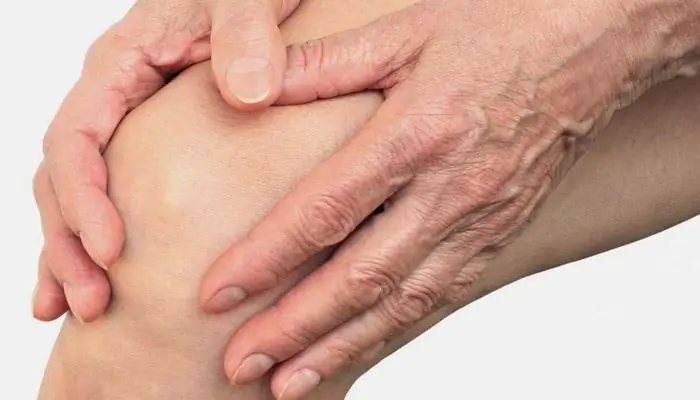
Disease classification
Given the causes that precede the onset of the disease, gonoarthrosisis divided into two types:
- Primary (idiopathic). Its appearance is not preceded by trauma. This type affects elderly patients. Usually, primary gonarthrosis affects both knee joints at once.
- Secondary. The cause of this type of disease is various knee injuries, developmental pathologies, and other diseases that lead to disorders in the joint. Secondary gonarthrosis usually affects one joint and can appear at any age.
Degrees of gonarthrosis of the knee joint
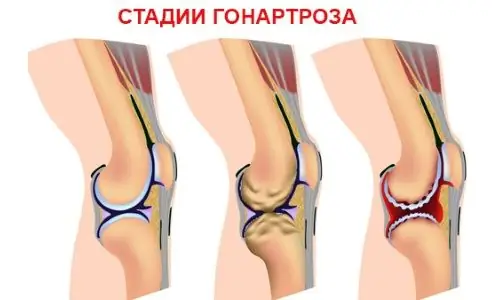
At first, the disease practically does not manifest itself, and a person may not suspect that he is developing such a serious illness as deforming arthrosis. Pathology can form over many years, the symptoms gradually increase. Gonarthrosis of the knee joint has three stages of development. The transition to each subsequent one is characterized by more pronounced pain and greater destruction of the cartilage tissue of the joints.
First stage
Gonarthrosis of the knee joint of the 1st degree is characterized by dull pains that appear periodically and, as a rule, after a serious load on the leg. Sometimes the knee may swell a little, and then the swelling goes away on its own. The joint is not yet deformed, but cracks appear on the cartilage, which, clinging to each other, prevent the joint from sliding smoothly.
Second stage
In the second stage of the disease, the symptoms intensify. Pain is more frequent, intense and prolonged. A crunch is often heard in the joints. Appearsome restrictions in movements, the reason for this is some deformation. Osteophytes resembling spikes begin to grow along the edges of the joint.
Third stage
Third - the last stage of gonarthrosis. At this stage, the disease reaches its maximum. The leg in the knee area hurts almost constantly, the person begins to limp. On x-ray, you can see a significant deformity of the joint. The knee is difficult to bend and unbend. Virtually no cartilage.
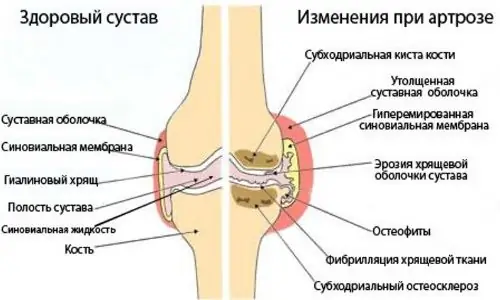
Why gonarthrosis develops
Usually, this disease is caused not by one factor, but by several at once. Most often, injuries become such a cause, for example, a person broke a shin, a torn or torn ligament occurred, a meniscus was damaged, and other traumatic injuries. But the disease does not appear immediately after the injury, usually several years pass after it. There are cases of development of gonarthrosis already 3-4 months after the injury.
The next reason for the development of the disease can be a significant load on the knee joint. It can be a big load during sports. Sometimes people over the age of 40, in order to maintain their he alth, begin to train hard. But at the same time, they do not take into account that at their age the state of the joints is no longer the same as at a young age. Large loads on the joints lead to degenerative-dystrophic changes in them. Gonarthrosis can provoke deep squats and running.
Another factor that can cause the developmentdisease, may become obese. A large weight increases the load on the musculoskeletal system, in particular on the knee joints. This can cause both minor microtraumas and more severe injuries, such as torn ligaments or menisci. If, in addition to being overweight, the patient also has varicose veins, then gonarthrosis is especially difficult.
The next provocateur of the disease can be any form of arthritis transferred earlier (rheumatoid, psoriatic, reactive and others).
The risk factors include neurological diseases that cause impaired innervation and metabolic disorders in the body, as well as genetic weakness of the ligaments. Various spinal injuries and traumatic brain injuries can cause the development of deforming arthrosis of the knee joints.
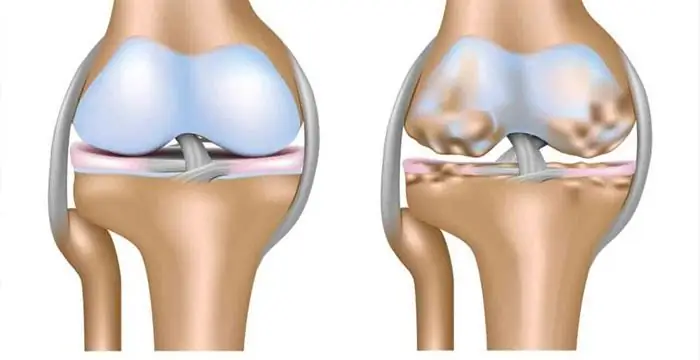
Main symptoms
At different stages of gonarthrosis of the knee, the symptoms differ significantly - from slight pain in the first stage to severe pain and deforming changes in the knee in the later stages of the disease.
In the first stage, the patient develops slight pain in the knees when he walks, sits down or stands up, goes up or down the stairs. As a rule, such sensations disappear when a person is in a calm state. At this stage, “starting” pain is characteristic, which occurs when a person needs to take the first steps, after he has sat or stood still for a long time.
If we consider the knee,then visually it is not changed. But some patients experience slight swelling. This is due to the fact that sometimes fluid accumulates in the joint, which leads to the development of synovitis. This, accordingly, leads to an increase in the volume of the joint, limitation of movement and a feeling of heaviness in it.
When the disease enters the second stage, pain becomes more pronounced. The joint hurts even with minor loads, the pain intensifies during intense movements. The place of localization of such pain is the anterointernal surface of the joint. When a person has the opportunity to rest for a long time, the pain disappears, but as soon as he starts to move again, the symptoms resume.
As the disease progresses, the range of motion of the diseased joint gradually begins to decrease. When moving, you can hear a crunch in the knee. Visually, the joint begins to expand, its configuration changes. Synovitis begins to appear more often and is characterized by a large accumulation of fluid. In the third stage of the development of gonarthrosis, pain almost does not leave a person. They do not allow him to live in peace, not only during movements, but also at rest. In order to fall asleep in the evening, the patient has to look for a comfortable position for a long time. Sometimes, even at night, the pain does not allow a person to sleep.
Both bending and unbending the joint becomes more and more difficult, even fully straightening the leg becomes impossible. There is a deformation and an increase in the joint in volume. Often, patients with gonarthrosis of the knee joints develop varus or valgus deformity of the legs, theybecome O-shaped or X-shaped. The deformity results in an unsteady and waddling gait. Sometimes patients find it so hard to walk that they use a cane or crutches.
Diagnosis of gonarthrosis
A significantly greater effect of treatment can be expected in case of timely treatment to a medical institution. At the very beginning of the disease, at its first stage, it is impossible to identify any external signs of gonarthrosis. Therefore, additional diagnostic tests are being carried out.
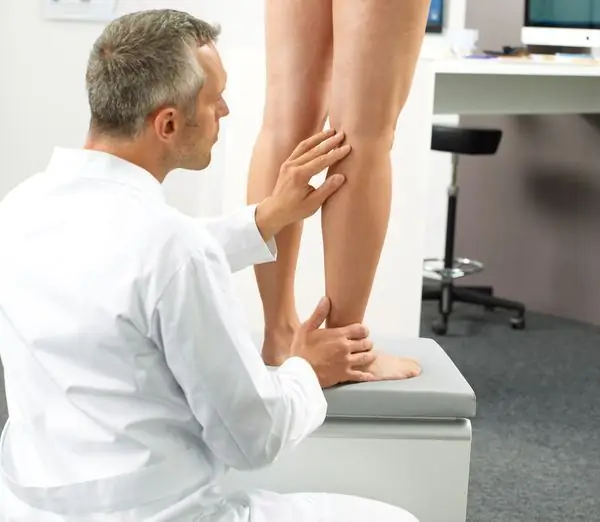
At later stages, a specialist can detect joint deformity, coarsened bone contours, curvature of the axis of the lower limb and restriction of movements in it. If you move the patella in the transverse direction, then a crack is usually heard.
A more accurate diagnosis can be made by taking an x-ray of the knee joint. Thanks to this research method, it is possible to determine how pronounced pathological changes in the joint are. Taking repeated pictures after a certain time, you can observe the development of the disease. X-ray is a very affordable and inexpensive procedure, so it has always been and remains the main way that helps determine the presence of gonarthrosis. Also, this method is necessary in order to exclude the presence of any other pathologies, such as tumors.
At the beginning of the disease, significant changes in the joints on x-rays may be absent. With further progression of the disease, a thickening of the subchondral zone is noticeable, as well as a narrowing of the joint space.
Diagnosis"gonarthrosis", as a rule, is put only if clinical and radiological signs of the disease are combined. Indeed, in older people, changes in the joints can also be observed on x-rays, but there are no pathological symptoms.
Computed tomography and MRI are also often used to make a correct diagnosis, which help to identify existing changes in soft tissues.
How to treat gonarthrosis of the knee joint
If "deforming arthrosis" is diagnosed, the orthopedist should deal with the treatment of this disease. The sooner the patient sees a doctor, the better, the result of treatment depends on it.

The following methods give good results:
- drug therapy;
- physiotherapy (laser, electrophoresis, ultrasound, magnetotherapy);
- healing mud;
- exercise therapy;
- massage.
Drug treatment includes the use of chondroprotectors. These drugs help improve metabolic processes in the diseased joint, prevent its destruction. Drugs that replace synovial fluid are also used. Sometimes a doctor may prescribe the administration of steroid hormones directly into the joint. Such patients are also shown spa treatment.
Patients can use individual insoles or special orthoses. To slow down the development of the disease, it is recommended to avoid heavy loads on the joints, engage in physiotherapy exercises, do not gain extra pounds, go tocomfortable shoes, properly alternate loads and rest.
Surgical treatment
If gonarthrosis has passed into the third stage of its development, then conservative treatment becomes ineffective. If a person is constantly tormented by severe pain, the joint cannot perform the functions assigned to it, and the patient is still quite young, then the best way to treat gonarthrosis of the knee joint is surgery. During surgery, the knee joint is replaced with an endoprosthesis. The rehabilitation period after the operation lasts from 3 to 6 months.
Therapeutic exercise
Exercise therapy is one of the methods of dealing with the disease. Only therapeutic exercises should be carried out under the supervision of the attending physician.
Recommended exercises for gonarthrosis of the knee:
- Walking in place with high knees.
- Standing on the support, do alternating flexion and extension of the legs at the knees.
- Move your feet from toe to heel without lifting them off the floor.
- Lie on your back. Bend the leg at the knee and pull the knee to the stomach, help with your hands. Repeat the same with the other leg.
There are quite a lot of such exercises, but in each individual case they should be selected by a specialist.
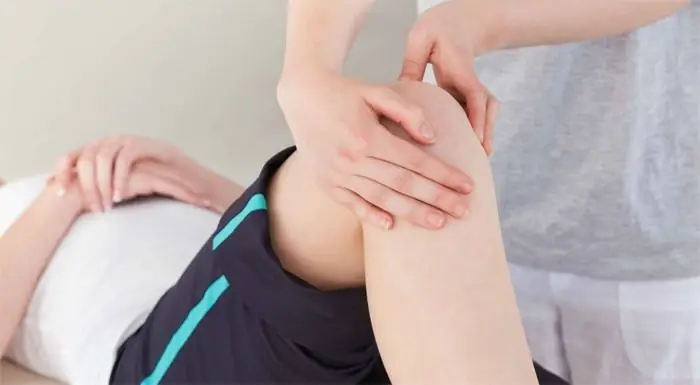
Folk treatments
Folk treatment has proven itself well in the fight against gonarthrosis of the knee joint. It suggests the use of ointments and compresses based on natural ingredients:
- Helps relieve pain and inflammationa compress of 3 tablespoons of apple cider vinegar and 1 tablespoon of honey.
- You can get a good result just by rubbing honey on the affected area, as this bee product has a pronounced antiseptic effect.
- Apply a leaf of cabbage or plantain to a sore knee.
- Insist on triple cologne dandelion leaves. Rub into the sore knee.
Treatment of gonarthrosis of the knee joint with folk remedies will help reduce pain, relieve inflammation, but it cannot completely cure this ailment.






